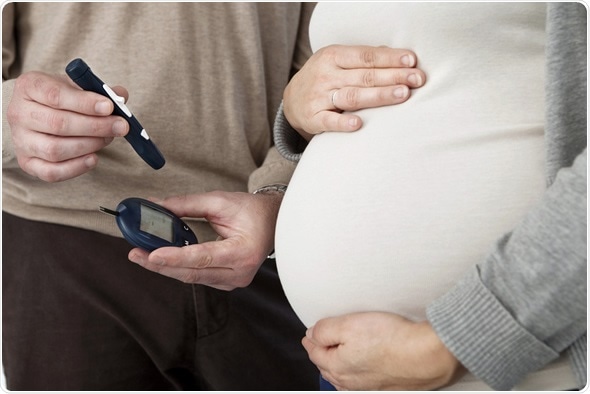A fetus growing inside a woman who has diabetes may be exposed to high levels of blood glucose during the pregnancy if the diabetes is not well controlled.
There are two types of diabetes that may put a baby at risk during pregnancy, namely, gestational diabetes and pre-gestational diabetes.
Gestational diabetes is a condition that develops during pregnancy in women who did not previously have diabetes. Pre-gestational diabetes refers to type 1 or type 2 diabetes that a woman already had prior to becoming pregnant and requires blood sugar lowering medications or insulin to treat it.
It is important to ensure that the diabetes is well controlled during pregnancy, otherwise the baby will be exposed to excess blood sugar levels that can affect it during pregnancy, during birth and after birth.

Test For Diabetes Pregnant Woman, Image Copyright: Image Point Fr / Shutterstock
When the diabetes is not properly controlled, the excess blood glucose is transferred to the fetus during pregnancy, which causes the baby to produce excess amounts of insulin.
The infant is then at risk of various complications including hypoglycemia, excessive birth weight, pre-term birth, respiratory distress syndrome, and birth injury.
If a woman has insulin-dependent diabetes, there is also an increased risk of birth defects that affect the formation of the heart, spinal cord, brain gastrointestinal system, and urinary tract.
Unlike insulin-dependent diabetes, in gestational diabetes, the blood glucose levels are generally normal throughout the critical first three months of pregnancy, when the baby’s organs are forming.
Risks to the Baby
Some of the complications that diabetes can lead to if it is not carefully managed during pregnancy are described in more detail below.
Excessive birth weight
If there is an excess of glucose in the maternal blood, it crosses the placenta and the baby’s pancreas senses the high glucose level. This causes the baby to produce an excess of insulin in an attempt to help use up the glucose. This can lead to the baby developing large deposits of fat and growing excessively large. This is referred to as macrosomia.
Babies that have reached a very large weight, of 9 pounds or more, are more likely to become stuck in the birth canal, which increases the risk of birth injury and the need for a caesarean section.
Hypoglycemia
Babies born to mothers with diabetes are at an increased risk of developing low blood sugar or hypoglycemia shortly after birth and during the first few days of life, since they are already producing an excess of insulin.
After birth, the baby continues to have an excess of insulin, but is no longer being exposed to the mother’s excess glucose level, which can result in too much glucose being used up and the blood sugar level therefore becoming very low. If the hypoglycemia is severe, the baby is at an increased risk of seizure.
The baby’s blood sugar level is checked after birth and if it is too low, intravenous glucose solution may be administered so that the blood sugar is restored to a normal level.
Early or pre-term birth
Having a high blood sugar level can increase the mother’s risk of going into labor early and having to have her baby delivered before the due date has been reached. A doctor may also recommend an early delivery due to the baby having grown too big.
Respiratory distress syndrome
Babies born pre-term are at an increased risk of respiratory distress, which is difficulty breathing. The excess insulin in the baby’s body can delay production of the surfactant required for lung maturation. These babies require assistance in order to breathe until their lungs have matured and strengthened.
Babies born to mothers with poorly controlled diabetes are also at a risk of respiratory distress even if they are not born early.
Type 2 diabetes later in life
Babies born to mothers with poorly controlled diabetes during pregnancy are also at an increased risk of becoming obese and developing type 2 diabetes later in life.
Further Reading